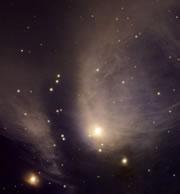 The Taurus Molecular Cloud contains some suprisingly complex molecules.NASA
The Taurus Molecular Cloud contains some suprisingly complex molecules.NASAAstronomers have found the largest negatively charged molecule so far seen in interstellar space. The discovery, of an organic compound, suggests that the chemical building blocks of life may be more common in the Universe than had been previously thought.
The molecule is a chain of eight carbons and a single hydrogen called the octatetraynyl anion (C8H¯). Two teams of scientists have spotted it near a dying star and in a cloud of cold gas.
The discovery, along with that of three smaller organic molecules in the past year, opens up a suite of potential chemical reactions and products. It suggests that 'prebiotic' molecules such as amino acids, the building blocks of protein, could form all over the Universe, says Tony Remijan, an astronomer at the National Radio Astronomy Observatory (NRAO) in Charlottesville, Virginia.
Remijan's team spotted the octatetraynyl anion in a dense cloud of gas in the halo surrounding a dying star in the constellation Leo, 550 light years from Earth. They made the discovery using the Green Bank Telescope in West Virginia, a radio dish 100 metres across.
Another team from the Harvard-Smithsonian Center for Astrophysics in Cambridge, Massachusetts, used the same telescope to spot the compound in the Taurus Molecular Cloud (TMC), located 450 light years from Earth in the constellation Taurus. Both findings are published in the Astrophysical Journal1,2
Watch this space
Negatively charged organic molecules such as the octatetraynyl anion were long thought to be confined to Earth. "People thought they were too fragile to exist [in space]," says Sandra Brünken, a member of the Harvard-Smithsonian team.
To show that octatetraynyl anion could be found in space, Brünken made the compound, along with several similar ones, in the lab. She then measured the chemical's spectrum — the same property radio telescopes hunt for. With this in hand, the two teams sifted through radio telescope measurements to find the molecule.
ADVERTISEMENT
Brünken and her colleagues discovered the first interstellar organic anion — a chain of six carbons and one hydrogen — by chance in late 2006 when they noticed a blip in the measurements from the TMC. The spectrum hinted at a compound called hexatriynyl anion, but confirmation only came when they made the compound in the lab and found that the two signatures matched up.
The researchers believe that even larger organic molecules are likely to be out there. Although more complex molecules are harder to identify, Remijan is confident of further discoveries. "They're really easy to find once you know what you're looking for," he says.
Visit our compoundfoundinthe.html">newsblog to read and post comments about this story.
